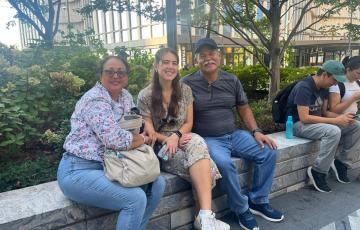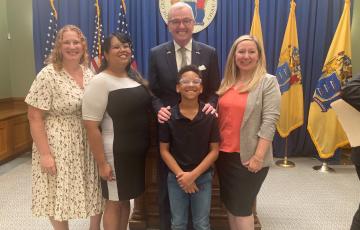Search Results
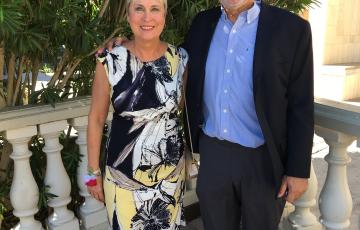
Lynn
I was diagnosed on Halloween 2008 with smoldering multiple myeloma (SMM). By 2011, I needed a stem cell transplant. After about a year and a half, I started on maintenance drugs. I started out with Velcade and progressed over the years to immunotherapy drugs.
I had very few side effects from these drugs and had remained strong and active, but everything started to catch up with me in 2021. I was deemed to be a good candidate for CAR-T-cell therapy, and in February of 2022, I was admitted for treatment.
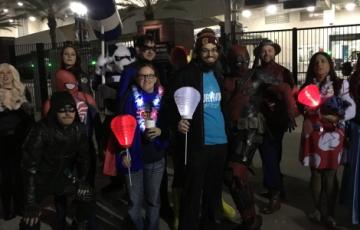
Sarah
My husband Patrick had a chest cold for about two months. I finally convinced him to go to the urgent care and they did an X-ray. Soon they found that he had an abnormally shaped aorta, so they sent him to our primary for testing.
They tested him and on July 5, 2017 and found that he had a mass in his chest that had caused his heart to move. It turns out the mass was Hodgkin lymphoma.
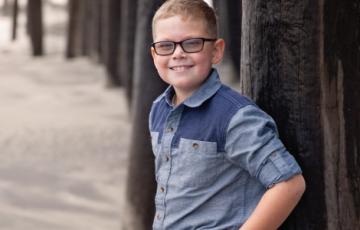
Austin
In May 2011, when Kimberly Schuetz was starting to plan her son Austin’s third birthday, he was diagnosed with a high-risk form of acute lymphoblastic leukemia.
Austin was immediately placed on a chemotherapy regimen. However, when a routine blood test revealed that he relapsed in October 2012, their only option was a bone marrow transplant to save his life. After that transplant, his cancer came back for the third time in May 2013.
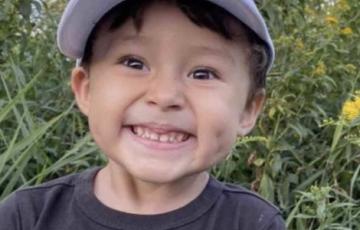
Shaden
Shaden is fighting against leukemia. He is three years old and was a healthy boy before his diagnosis. Then, out of nowhere, he would get a lot of body aches that were very unusual.
Sometimes Shaden didn’t feel like being the happy, energetic kid he always was. He wouldn’t walk, sleep or eat. We decided to take Shaden to the children’s hospital and they did some testing. They soon told us that he might have leukemia. They did more testing, and Shaden was diagnosed with acute myeloid leukemia (AML).
Development of cellular therapy for CMML and the Immune landscape of response and resistance
We will test the efficacy of CAR T cell therapy for CMML. We will modify the tumor microenvironment to enhance their efficacy. and we will upscale CAR T cells to the next level in terms of their genetic structure.Treatment for Indolent NHL Subtypes
Indolent non-Hodgkin lymphoma (NHL) subtypes progress slowly. They make up about 40 percent of all NHL cases in the United States. Indolent subtypes include:
Relapsed and Refractory
Relapsed CLL is the term for disease that returns after it has been in remission for more than six months.
Refractory disease is the term for CLL that does not result in remission after initial therapy.

Nathaniel
Hi! Nathaniel here, but you can call me Nate. I am an 18-year-old North Carolina Scholar, 2015 graduate of Franklinton High School who graduated with high honors. I am a future student of the University of North Carolina at Charlotte, majoring in mechanical engineering. I am a son, brother, grandson, nephew, cousin, boyfriend, friend, percussionist, musician, scholarship recipient, car and truck enthusiast, minority mentor, and an all around "Renaissance Man" with a philanthropist heart. I also have cancer

Jack
Jack is an eight-year-old boy in second grade at Gayton Elementary School. He has a passion for all things sports, soccer being his favorite. He also plays baseball, basketball, participates in a swim team in the summer, and has recently taken up tennis. Jack also enjoys doing anything outside whether it’s riding bikes, shooting baskets, sailing, fishing or building forts with his twin sister, Ellie and younger brother, Landon. You won’t find him too far from a Lego set, and will whip up intricate cars, spaceships and villages in no time.
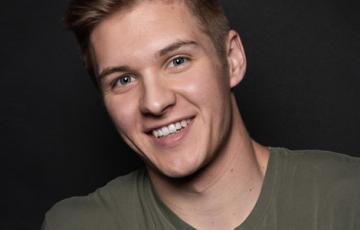
William
Hi, my name is William Yank and I am a 23-year-old, three-time leukemia survivor from Indiana. My story begins at the end of my junior year of college. I had just secured an internship in Washington D.C and was excited to finally spend a summer on my own. The summer started off pretty rough. I struggled to find affordable housing in D.C, I had no idea how the transportation system worked, and food was twice as expensive as compared to Indiana. Not to mention, I was only 20-years-old having fun was next to impossible.
Chemotherapy and Drug Therapy
Chemotherapy is the mainstay of treatment for HL. A combination chemotherapy regimen consists of two or more chemotherapy drugs. Generally, the drugs are dissolved in fluid and usually administered via a peripheral intravenous (IV) line. If finding an accessible vein is problematic, a central line (a port, or a peripherally inserted central venous catheter (a PICC or PIC line) may be used for some HL patients.
'Chemobrain'
Chemotherapy and radiation therapy can cause problems with cognitive (mental) functions, such as concentration, memory and the ability to multitask. Most chemotherapy patients experience these effects, sometimes referred to as “chemobrain” or brain fog, to some degree, although doctors are unable to predict who might be affected.
The cognitive effects of chemotherapy for some are long-lasting. A small percentage of patients have long-term effects known as "chemotherapy-induced cognitive impairment." The symptoms include a mental fogginess and effects on:
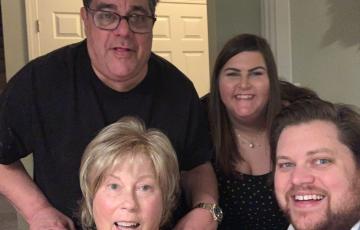
Geoffrey
My wife was diagnosed with acute lymphoblastic leukemia (ALL) in November 2014. She went through a three-year protocol of a steroid regimen followed by one year of oral chemotherapy. She was pronounced in remission after one segment of chemotherapy but went through the entire protocol. Living in Chicago at the time, she was treated at Northwestern under Dr. Diner, a specialist in her type of ALL. Then in 2020, we moved to North Carolina and were referred to Dr. Kataryna Jamieson at UNC Hospital for what we thought would be a yearly or biannual checkup. In July of 2020, Dr.
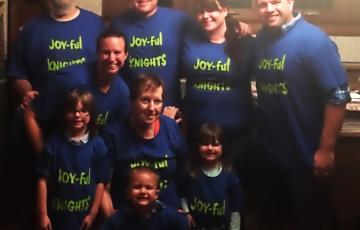
Joy
My mother, Joy, was diagnosed in 2015 with follicular lymphoma (FL) in her stomach. She went into remission after chemo treatment. Six months later, it came back, this time more aggressive and on the outside of her organs. They did CHOP chemo and then a bone marrow transplant. She went into remission for a second time. Eight months later, she wasn't feeling spectacular, so we took her back to the doctor. She was diagnosed with large B-cell lymphoma (DLBCL). The mass was in her uterus and had grown so fast and massive that it blasted through her bladder.
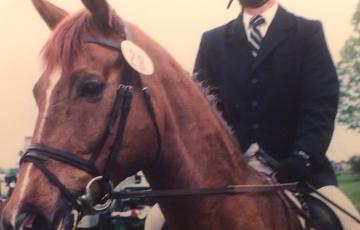
Gil
I was sitting alone in a stark, clean examination room on September 16, 2021, at the Dana Farber Cancer Institute (DFCI) in Brookline, Massachusetts when my oncologist walked in. I called my spouse and son on my cell phone so they could hear the results.

Laura
My mom was diagnosed with non-Hodgkin lymphoma (NHL) in August 2022. Over the course of a year, she underwent chemotherapy, caught COVID-19, underwent CAR-T therapy, and fought through many respiratory infections. My mom was a fighter. She wasn’t going to let a cancer diagnosis slow her down. She wanted to live. Between me and my sisters, we all took turns taking my mom to all her appointments.
Relapsed and Refractory
Some patients have residual leukemia cells in their bone marrow even after they receive intensive treatment. In these cases, the disease is referred to as being “refractory” (or “refractory ALL”).
Other patients achieve remission but later have decreased numbers of normal blood cells and a return of leukemia cells in their bone marrow. This is referred to as a “relapse” of the disease (or “relapsed ALL”).
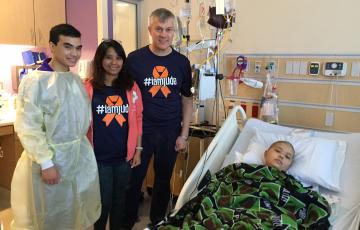
Jude
At age five, on my fourth day of kindergarten, I was diagnosed with acute lymphoblastic leukemia (ALL). With the 85% survival rate for ALL, I was confident I would go through this for the next three years but one month later after the induction period, my doctor told us I didn’t respond and I may need a bone marrow transplant.

Kate
"You have cancer" is one of the scariest things you might ever hear. When Kate was diagnosed with non-Hodgkin lymphoma (NHL), she initially thought about how she wasn't strong enough and how she wasn't ready to die. Then she calmed down and told herself she didn't really have a choice.
"You have to do this; you have to be strong."
Refractory and Relapsed Childhood ALL
Most children with ALL are cured with standard chemotherapy treatments. But about 15 percent of young patients have ALL that returns after remission. This is referred to as a “relapse” of the disease (or “relapsed ALL”). Some children are unable to achieve a remission because their cancer does not respond to treatment. In these cases, the disease is referred to as “refractory” (or “refractory ALL”).
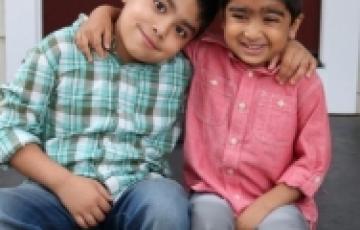
Kabir
Kabir is an eight-year-old boy who is very affectionate, loving, and sweet. He has endless interests and loves dogs, superheroes, ponies, mermaids, magic shows, zoos, roller coasters, rock collecting, traveling, eating at "fancy" restaurants, watching television and movies, building Legos, and playing video games. Before his diagnosis, Kabir also enjoyed swimming and Brazilian Jiu Jitsu. He is caring by nature and an amazing older brother to his younger sibling, Ayaan.
